
VNU Journal of Economics and Business, Vol. 4, No. 6 (2024) 13-20
13
Original Article
Exploring digital human resource management practices
in the telecommunication sector in Vietnam
Tran Thi Nhung*, Dang Thi Huong Thao
VNU University of Economics and Business
No. 144 Xuan Thuy Street, Cau Giay District, Hanoi, Vietnam
Received: October 30, 2024
Revised: December 06, 2024; Accepted: December 25, 2024
Abstract: This study explores the implementation of digital human resource management (HRM)
practices within organizations through a qualitative lens. Semi-structured interviews were conducted
with nine employees and managers to understand their experiences and perceptions of digital HRM
systems. Our findings suggest that digital HRM has been applied in companies in
Telecommunication sector in Vietnam at different functions and scope. However, the research also
highlights the importance of considering employee adoption, organizational culture, and
technological challenges. Limitations include a small sample size and the absence of quantitative
data. Future research will employ a larger sample and mixed-methods approach to comprehensively
examine the impact of digital HRM on organizational performance and employee outcomes.
Keywords: Digital HRM practices, telecommunication sector, Vietnam.
1. Introduction *
In Vietnam, the economy and organizations
and businesses are operating in the context of
digital transformation with attention and
strategic investment from state management
agencies. Especially after the COVID-19 period,
all countries in the world, including Vietnam,
have recognized the importance of digital
transformation. In 2020, the Prime Minister
approved Decision No. 749/QD-TTg “National
Digital Transformation Program to 2025, with a
________
* Corresponding author
E-mail address: nhungtran@vnu.edu.vn
https://doi.org/10.57110/vnu-jeb.v4i6.351
Copyright © 2024 The author(s)
Licensing: This article is published under a CC BY-NC
4.0 license.
vision to 2030.” Accordingly, this Decision
promotes the digital transformation of business
organizations and especially state agencies to
gradually transform and digitize data, processes
and procedures. In addition, the Ministry of
Information and Communications has also
approved a project to assess the level of digital
transformation of enterprises and support the
promotion of digital transformation of
enterprises (Egov, 2023). According to the
project, the level of digital transformation of
enterprises is divided into 6 levels and the
Copyright © 2024 The author(s)
Licensing: This article is published under a CC BY-NC
4.0 license.
VNU Journal of Economics and Business
Journal homepage: https://jeb.ueb.edu.vn

T.T. Nhung, D.T.H. Thao / VNU Journal of Economics and Business, Vol. 4, No. 6 (2024) 13-20
14
subjects of application include enterprises,
cooperatives, production and business
establishments of all economic sectors, in all
industries, fields, and locations nationwide, with
different scales (micro, small, medium, large).
Thus, the context of digital transformation in
Vietnam has been clearly formed and developed,
affecting all types of enterprises and fields in
Vietnam.
HRM has been studied in recent years under
the impact of global digital transformation.
Sengupta et al. (2021) explore the application of
SMAC technologies (Social, Mobile, Analytics,
Cloud) to HRM functions. Vardarlier (2020)
studies the digitalization of payroll processes,
data management, internal communications and
other features. Fenech et al. (2019) delve into the
function of HRM in the digital transformation
process at enterprises and argue that
digitalization supports routine operations well
but has not had much impact at the strategic
level. Strohmeier’s (2020) research focuses on
clarifying concepts related to digital HRM,
highlighting the common use of terms such as
digital HRM, digital HRM transformation...
Accordingly, he points out that these terms are
being used in similar contexts with similar layers
of meaning, all referring to the application of
technology to HRM in the current digital age and
all having different emphases in terms of process
and method. In addition, many studies delve into
the application of new technologies to HRM
such as systems applying AI, Big Data, etc. It is
noticeable that both the practical and academic
world are paying attention to digital HRM with
more and more studies on this topic.
As a result, there have been some studies in
Vietnam digging into the topic of digital HRM.
The impact of digital HRM on organization
performance has been studied by Kieu (2021),
Tran et al. (2021) while Do (2023) explored the
digital transformation of HRM in industrial
zones. Specifically Kieu (2021) found the
positive effect of digital HR practices on
business outcomes of companies by quantitative
analysis with more than 200 samples collected
from Vietnam. Do (2023) emphasized the
urgency of applying digital HRM in industrial
zones in Bac Ninh province. Tran et al. (2021)
discussed mainly the trends of digital HRM and
proposed some solutions. It can be seen that most
researches focus on literature reviews with few
studies exploring the practices of digital HRM.
In addition, there has been no research so far
investigating the digital HRM in the
Telecommunication sector in Vietnam.
Therefore, the authors would like to bridge
the gap with this paper to provide an overview of
digital HRM practices in telecommunication
companies.
The Telecommunication sector includes
high tech organizations with continuous
innovation and new technology application.
HRM systems in this sector can be the leading
examples for other companies to follow.
Accordingly, our research question is: How do
companies in the Telecommunication sector in
Vietnam implement digital HRM practices?
2. Literature review
Digital HRM is a term used in the research
of Halid et al. (2020), Wang et al. (2022), and
Kieu (2021). This is a commonly used term and
is a research trend of many scholars. Saini (2018)
defines digital HRM as a management activity
based on digital technology platforms,
applications and the Internet to build an
integrated system serving both employees and
managers.
Sengupta et al. (2021) shared a similar
approach which link digital HRM to modern
technologies named SMAC - Social, Mobile,
Analytics and Cloud. It can be seen that there has
been mutual agreement on the technology
application of HRM to transform digital
practices of all HRM functions.
Specifically, Sengupta et al. (2021) studied
the changes in HR functions under the
application of technology. Accordingly, the four
main functions identified in the study include:
Recruitment and selection: Currently, up to
70% of companies have applied technology in
recruitment and this is expected to increase to
85% in the near future (Sengupta et al., 2021).
The application of technology in recruitment is
demonstrated through: posting recruitment
information and job descriptions on digital
platforms such as websites, social media, and
applications; through collecting online
applications; and conducting testing and
interview rounds through online tools. Some
recruitment platforms in Vietnam apply

T.T. Nhung, D.T.H. Thao / VNU Journal of Economics and Business, Vol. 4, No. 6 (2024) 13-20
15
algorithms that can automate the screening of
applications based on specific criteria such as
TopCV, Navigos. In addition, AI technology has
also been used in interviews and assessments,
predicting candidates’ abilities (Lee & Kim,
2021; Budhwar et al., 2022). Overall, digital
recruitment is understood as the recruitment
process that utilizes technology in attracting
candidate sources and screening candidates
through online platforms and applications.
Training and development: Digital training
is a concept developed from e-learning in
education, according to which training is applied
with technology and digital techniques, in which
teachers and learners can communicate and
interact through many online forms (Trinh,
2012; Vardarlier, 2020). The training function
has been supported early by the digitization of
learning materials, the deployment of online
lectures and this has been promoted during the
COVID-19 period. Deploying online training
with a digital learning material system helps
personalize the learning process, and is
convenient in terms of time and space for
employees to develop themselves. However, the
limitations in the ability to interact, monitor and
support learners need to be supported by
organizations with specific support measures.
The training system may include each
employee’s development plan as well as links to
the performance management system to
promptly identify training needs and develop
training implementation plans.
Performance management: With many
supporting software and technology systems,
performance management has been continuously
improved with many functions to effectively
evaluate employee performance as well as
provide timely feedback. The systematization of
this function supports the monitoring of goals
and completion progress as well as coordination
with different departments. The application of
additional algorithms and data processing also
helps to predict development potential, serving
the purpose of rewarding and planning human
resources.
Compensation and benefits: some basic
activities such as timekeeping and salary
calculation have long been integrated with
technology to increase accuracy and efficiency.
In addition, administrative procedures will be
minimized, and parties including employees,
managers, and human resources departments can
monitor the work process and corresponding
salary and benefit changes.
In addition to the above common functions,
other administrative functions of HRM have
been and are being applied with technology to
specifically support the Employee Information
Portal and the human resource data system.
Information support for employees is provided
by a centralized portal so that employees can
easily access personal information, company
policies, and important announcements. This is
also the function of the Human Resource
Information System - HRIS that has been
deployed since the 2000s. Today, the system can
be integrated with automated consulting tools
(chatbots) or integrated with AI to answer
questions and interact with employees.
Moreover, with diverse and fully updated
human resource data, automating the Human
Resource Management Process and Relevant
Data Analysis to predict and manage changes in
the organization will help reduce errors and
increase the effectiveness of HRM (Bredin &
Söderlund, 2011).
3. Research methodology
A qualitative approach offers a deep look
into digital HRM practices within organizations.
By employing methods such as interviews and
case studies, the authors aim to uncover the
practical situations as to how digital HRM
functions are being implemented. This approach
allows for exploration of the practical
implementation behind technology adoption,
including employee experiences, usage and
challenges faced during implementation.
Qualitative research also enables researchers to
understand the contextual factors around digital
HRM initiatives, providing rich data for
understanding the real situations and developing
recommendations.
To be more specific, semi-structured
interviews is one of the popular methods in
qualitative research that has been adopted. By
providing a flexible framework with open-ended
questions, researchers can explore employees’
and managers’ experiences with digital HRM
systems. Interviews with employees can
illuminate the impact of these systems on daily

T.T. Nhung, D.T.H. Thao / VNU Journal of Economics and Business, Vol. 4, No. 6 (2024) 13-20
16
work life, experiences, and perceived efficiency.
For instance, questions about ease of use, access
to information, and the role of technology in
communication can provide valuable insights.
Conversely, interviews with managers offer a
strategic perspective on the implementation and
outcomes of digital HRM in managing
employees. Exploring issues such as
convenience, performance management support
and reporting functions help authors to
understand the broader organizational context.
By combining employee and managerial
perspectives, researchers can gain more
comprehension of digital HRM practices.
For sample collection, snowball techniques
have been applied which the authors based on the
connection network that developed when the
authors asked to be introduced to employees in
the Telecommunication sectors. The
interviewees then also provided introductions to
other interviewees who joined the research.
Overall, nine participants were approached for
semi-structured interviews to provide diverse
perspectives on digital HRM practices. The
sample included a mix of employees from
various departments and levels, as well as
managers with varying degrees of involvement
in HR functions. This purposeful sampling
strategy aimed to capture a broad range of
experiences and opinions. Interviews were
conducted in a private setting to encourage open
and honest dialogue. To ensure consistency and
comparability, a semi-structured interview guide
was developed, covering key themes such as
technology adoption, employee experience,
organizational impact, and challenges faced. It
should be noted that all interviews were
conducted in Vietnamese and then translated to
English for this paper. As conducted under semi-
structured interviews, some questions that were
prepared are as follows:
(1) Please tell us about your role and the
company you are currently employed at.
(2). Is there any digital tool or software used
in your company for HR management?
(3) What are the main features you use on
this HR software?
(4) How often do you use this application?
(5) What specific aspects of your work does
this HR software assist you with?
(6) How would you compare this HR
software to other HR systems you have used
before?
(7) What features would you like to see
added or improved in this HR software?
(8) Were the questions in this survey easy to
understand?
(9) Do you have any suggestions for
improving the survey questions or content?
Other questions were proposed during the
interview, based on the answers of interviewees.
Table 1: Interviewees participating in the research
Interviewee
code
Position
Organization
Area
C1
Employee
CMC
Hanoi
C2
Employee
CMC
Hanoi
M1
Employee
MobiFone
Hanoi
M2
Manager
MobiFone
Hanoi
V1
Manager
Viettel
Hai
Duong
F1
Manager
FPT
HCM
City
F2
Employee
FPT
Hanoi
N1
Employee
VNPT
Hanoi
Source: Authors.
4. Main findings
As mentioned above, Vietnam’s
telecommunication sector has rapidly embraced
digital transformation, and Human Resource
Management (HRM) is no exception. Leading
players like FPT and Viettel have demonstrated
a strong commitment to technological
innovation by developing internal digital HRM
systems. This approach allows for tailored
solutions that align closely with their
organizational culture and specific HR needs.
Meanwhile, VNPT has opted for a commercial
platform, Odoo, to build its HRM system,
benefiting from pre-built functionalities while
customizing it to suit their requirements. CMC,
in collaboration with SAP, has implemented
SuccessFactors, a comprehensive digital
management system including various HR
functions. MobiFone is also investing in digital
HR by developing its own ERP system,
indicating a growing trend towards integrated
HR solutions. These companies' swift adoption
of technology highlights their forward-thinking

T.T. Nhung, D.T.H. Thao / VNU Journal of Economics and Business, Vol. 4, No. 6 (2024) 13-20
17
approach to digital HR management and their
recognition of the strategic importance of digital
transformation in driving business success.
By collecting qualitative data via in-depth
interviews with employees and managers at five
major corporations: Viettel, VNPT, MobiFone,
FPT, and CMC, the authors have explored
details of digital HRM practices in daily work.
Additionally, the study incorporates secondary
data from reports, official websites and publicly
available information on these enterprises.
Accordingly, the current state of digital HRM
will be exploited through the main functions of
HRM including: Recruitment and Selection,
Training and development, Performance
Management and Compensation and Benefits
management.
Recruitment
100% of the interviewed businesses use
recruitment websites, social media platforms and
partners’ recruitment pages to post job
information and receive candidate applications.
However, few corporations have built a
centralized recruitment system and integrated it
with HRM systems. In particular, VNPT has a
centralized recruitment information portal
(Talent Acquisition Management System -
TAMS) that manages job positions, candidate
profiles, and supports the organization of online
recruitment events (VNPT, 2021). FPT has the
website fptjobs.com and Viettel has the website
tuyendung.viettel.vn to receive and store
candidates' profiles directly. Candidate profiles
are stored in the cloud, allowing easy access and
seamless updates on the outcomes of each
recruitment round. Other enterprises such as
MobiFone, and CMC keep compiling the list of
candidates through email, the cloud, and using
obsolete methods in Excel. Interviewer F2 from
FPT stated that the applicants are required to fill
in their information online on the recruitment
website. While the C2 respondent is still
required to submit through email.
Selecting candidates through online testing
and interview methods have not yet become
widespread. Some businesses have integrated
this process in their HRM system such as FPT,
VNPT and Viettel. Nevertheless, AI and Big
Data applications have not been broadly applied.
It can be seen that although digital recruitment
has been widely implemented, methods and
effectiveness are not yet uniform.
Training and development
Training and development is a mission that
all telecommunication enterprises have focused
on and invested heavily in recently. The
surveyed enterprises all have platforms for
digital training, e-learning, and course data
warehouses, although the training process is
managed through digital platforms differently.
In addition to Viettel Academy - a school
dedicated to professional training, Viettel owns
the E-learning/LMS online learning system that
provides a synchronous training database that is
continuously updated and built for all
employees. Nearly 100 training courses for more
than 30,000 employees in offline and online
forms are organized every year (Nguyen, 2024).
While the digital training systems of VNPT and
FPT are separate from the HRM system, those of
Viettel and CMC are integrated. According to
respondent V1.
“When I log in to the system, I can access my
training courses and my employees’ courses, as
well as the training process and results of each
employee in their personal profile.” - V1
C2 respondent from CMC indicated that
employees use the SAP system to participate in
training courses. Meanwhile, MobiFone has an
e-learning training system at
elearningmds.mobifone.vn, but respondent M1
stated that they had not been informed about
online courses here.
“I know there is a platform for e-learning
somewhere but I was not required to take part in
and rarely informed or reminded on that
platform.” - M1
In addition to the available online training
courses, the offline training organization is still
being implemented. Thus, digital training is
increasingly being invested in by Vietnamese
telecommunications enterprises. However, the
application of technology is not yet consistent
among enterprises; moreover, specific activities
in the training process still require smooth
coordination between offline and online
activities throughout the system.
Performance evaluation
Nowadays, with technology, many
Vietnamese enterprises have integrated
evaluation criteria into their employee
evaluation systems, making the evaluation
process more systematic and effective. While
Viettel, VNPT, CMC, and FPT evaluate the

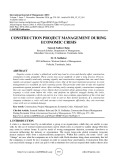
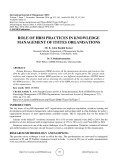
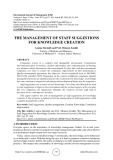
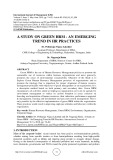
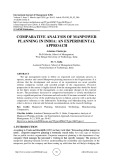
![Đề án quản lý và phát triển nhân sự tại đơn vị cấp phòng [Chuẩn SEO]](https://cdn.tailieu.vn/images/document/thumbnail/2017/20170419/msy1976/135x160/2751492583749.jpg)


![Tài liệu đào tạo, bồi dưỡng lãnh đạo cấp phòng [Mới Nhất]](https://cdn.tailieu.vn/images/document/thumbnail/2017/20170210/nomoney3/135x160/2145657834.jpg)
















